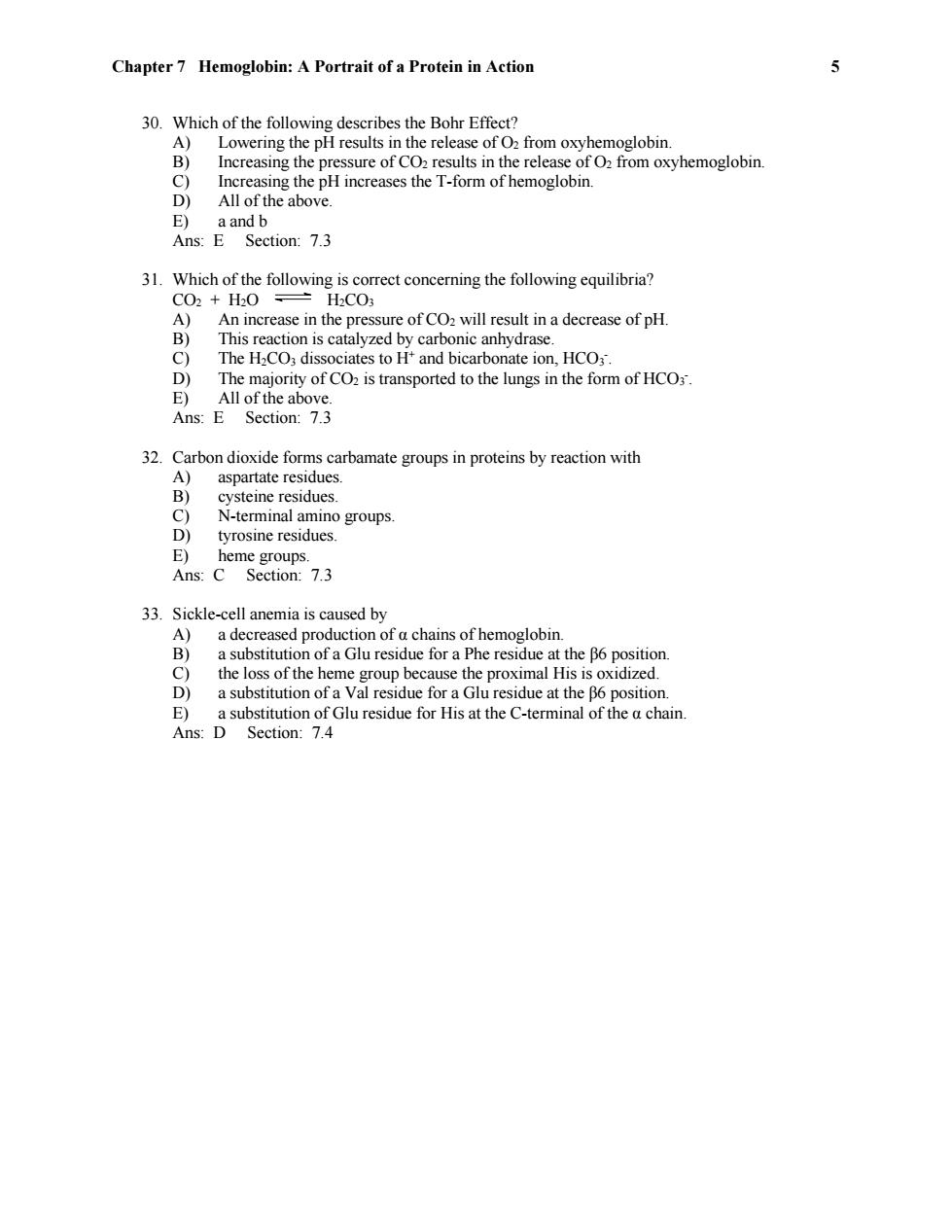正在加载图片...

Chapter 7 Hemoglobin:A Portrait of a Protein in Action 30.Which of the following describes the Bohr Effect? A) Lowering the pH results in the release of O2 from oxyhemoglobin. B) Increasing the pressure of CO2 results in the release of O2 from oxyhemoglobin. c) Increasing the pH increases the T-form of hemoglobin. D) All of the above. E)a and b Ans:E Section:7.3 31.Which of the following is correct concerning the following equilibria? C02+H20=H2CO3 A)An increase in the pressure of CO2 will result in a decrease of pH. B This reaction is catalyzed by carbonic anhydrase. C) The H2CO3 dissociates to H'and bicarbonate ion,HCO3. D) The majority of CO2 is transported to the lungs in the form of HCO3. E) All of the above. Ans:E Section:7.3 32.Carbon dioxide forms carbamate groups in proteins by reaction with A)aspartate residues. B) cysteine residues. C) N-terminal amino groups. D) tyrosine residues. E) heme groups. Ans:C Section:7.3 33.Sickle-cell anemia is caused by A) a decreased production of a chains of hemoglobin. B) a substitution of a Glu residue for a Phe residue at the B6 position. C)the loss of the heme group because the proximal His is oxidized. D) a substitution of a Val residue for a Glu residue at the B6 position. E)a substitution of Glu residue for His at the C-terminal of the a chain. Ans:D Section:7.4Chapter 7 Hemoglobin: A Portrait of a Protein in Action 5 30. Which of the following describes the Bohr Effect? A) Lowering the pH results in the release of O2 from oxyhemoglobin. B) Increasing the pressure of CO2 results in the release of O2 from oxyhemoglobin. C) Increasing the pH increases the T-form of hemoglobin. D) All of the above. E) a and b Ans: E Section: 7.3 31. Which of the following is correct concerning the following equilibria? CO2 + H2O H2CO3 A) An increase in the pressure of CO2 will result in a decrease of pH. B) This reaction is catalyzed by carbonic anhydrase. C) The H2CO3 dissociates to H+ and bicarbonate ion, HCO3 -. D) The majority of CO2 is transported to the lungs in the form of HCO3 -. E) All of the above. Ans: E Section: 7.3 32. Carbon dioxide forms carbamate groups in proteins by reaction with A) aspartate residues. B) cysteine residues. C) N-terminal amino groups. D) tyrosine residues. E) heme groups. Ans: C Section: 7.3 33. Sickle-cell anemia is caused by A) a decreased production of α chains of hemoglobin. B) a substitution of a Glu residue for a Phe residue at the β6 position. C) the loss of the heme group because the proximal His is oxidized. D) a substitution of a Val residue for a Glu residue at the β6 position. E) a substitution of Glu residue for His at the C-terminal of the α chain. Ans: D Section: 7.4